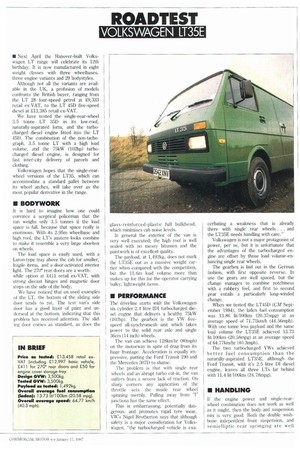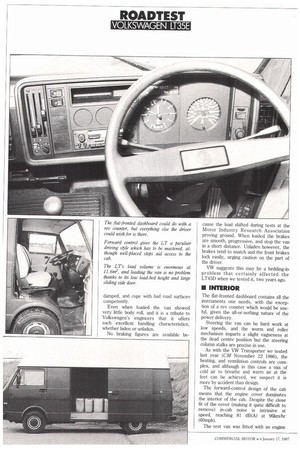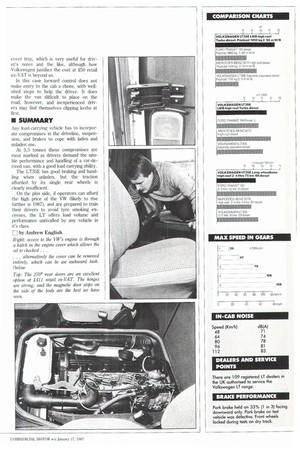HANDLE WITH CARE
Page 34

Page 35

Page 36

Page 37

If you've noticed an error in this article please click here to report it so we can fix it.
Volkswagen's LT35E offers excellent handling, marred only by poor rear wheel traction. It doesn't come cheap, but offers more load volume than any other vehicle in its class
• Next April the Hanover-built Volkswagen LT range will celebrate its 12th birthday. It is now manufactured in eight weight classes with three wheelbases, three engine variants and 29 bodystyles.
Although not all the variants are available in the UK, a profusion of models confronts the British buyer, ranging from the LT 28 four-speed petrol at £9,333 retail ex-VAT, to the LT 451) five-speed diesel at £13,385 retail ex-VAT.
We have tested the single-rear-wheel 3.5 tonne LT 351) in its low-roof, naturally-aspirated form, and the turbocharged diesel engine fitted into the Li" 451). The combination of the non-tacho graph, 3.5 tonne Li with a high load volume, and the 75kW (102hp) turbo charged diesel engine, is designed for fast inter-city delivery of parcels and clothing.
Volkswagen hopes that the single-rearwheel versions of the LT35, which can accommodate a standard pallet between its wheel arches, will take over as the most popular derivative in the range.
• BODYWORK
It is hard to imagine how one could convince a sceptical policeman that the van weighs only 3.5 tonnes if the load space is full, because that space really is enormous. With its 2.95m wheelbase and high roof, the LT's austere looks combine to make it resemble a very large shoebox on wheels.
The load space is easily used, with a Luton-type tray above the cab for smaller, fragile items, and a door-activated interior light. The 2700 rear doors are a worth
while option at ,£411 retail ex-VAT, with strong diecast hinges and magnetic door stops on the side of the body.
We have noticed that on used examples of the LT, the bottom of the sliding side door tends to rot. The test van's side door has a good layer of paint and underseal at the bottom, indicating that this problem has received attention. The sliding door comes as standard, as does the
glass-reinforced-plastic full bulkhead, which minimises cab noise levels.
In general the exterior of the van is very well executed; the high roof is well sealed with no messy bitumen and the paintwork is of excellent quality.
The payload, at 1,492kg, does not mark the LT35E out as a massive weight carrier when compared with the competition, but the 11.6m load volume more than makes up for this for the operator carrying bulky, lightweight items.
• PERFORMANCE
The driveline starts with the Volkswagen six cylinder 2.4 litre 11)1 turbocharged diesel engine that delivers a healthy 75kW (102hp). The gearbox is the VW fivespeed all-synchromesh unit which takes power to the solid rear axle and single 36cm (14 inch) wheels.
The van can achieve 1281m/hr (80mph) on the motorway in spite of drag from its huge frontage. Acceleration is equally impressive, putting the Ford Transit 190 and the Mercedes 3071) to shame.
The problem is that with single rear wheels and an abrupt turbo cut-in, the van suffers from a severe lack of traction. On sharp corners any application of the throttle sets the inside rear wheel spinning merrily. Pulling away from junctions has the same effect.
This is embarrassing, potentially dangerous, and promotes rapid tyre wear. VW's Nigel Brotherton says that although safety is a major consideration for Volkswagen, "the turbocharged vehicle is exa
cerbating a weakness that is already there with single rear wheels. . and the LT35E needs handling with care."
Volkswagen is not a major protagonist of power, per se, but it is unfortunate that the advantages of the turbocharged engine are offset by those load volume-enhancing single rear wheels.
The gearbox is laid out in the German fashion, with first opposite reverse. In use the gears are well spaced, but the change manages to combine notchiness with a rubbery feel, and first to second gear entails a particularly long-winded change.
When we tested the LT45D (CM September 1934), the laden fuel consumption was 13.86 liti100km (20.37mpg) at an average speed of 71.71km/li (44.56mph). With one tonne less payload and the same load volume the LT35E achieved 13.73 lit/100km (20.58mpg) at an average speed of 64.77km/hr (40.3mph).
The two turbocharged VWs achieved better fuel consumption than the naturally-aspirated LT35E, although the Ford Transit, with it's 2.5 litre DI diesel engine, leaves all three LTs far behind with 11.4 lit/100km (24.78mpg).
• HANDLING
If the engine power and single-rearwheel combination does not work as well as it might, then the body and suspension mix is very good. Both the double wishbone independent front suspension, and semielliptic rear springing are well damped, and cope with bad road surfaces competently.
Even when loaded the van showed very little body roll, and it is a tribute to Volkswagen's engineers that it offers such excellent handling characteristics, whether laden or unladen.
No braking figures are available be cause the load shifted during tests at the Motor Industry Research Association proving ground. When loaded the brakes are smooth, progressive, and stop the van in a short distance. Unladen however, the brakes tend to snatch and the front brakes lock easily, urging caution on the part of the driver.
VW suggests this may ,be a bedding-in problem that certainly affected the LT45D when we tested it, two years ago.
II INTERIOR
The flat-fronted dashboard contains all the instruments one needs, with the excep tion of a rev counter which would be useful, given the all-or-nothing nature of the power delivery.
Steering the van can be hard work at low speeds, and the worm and roller mechanism imparts a slight vagueness at the dead centre position but the steering column stalks are precise in use.
As with the VW Transporter we tested last year (CM November 22 1986), the heating, and ventilation controls are complex, and although in this case a mix of cold air to breathe and warm air at the feet can be achieved, we suspect it is more by accident than design.
The forward-control design of the cab means that the engine cover dominates the interior of the cab. Despite the close fit of the cover (making it quite difficult to remove) in-cab noise is intrusive at speed, reaching 81 dB(A) at 961cm/hr (60mph).
The test van was fitted with an engine cover tray, which is very useful for driver's notes and the like, although how Volkswagen justifies the cost at £50 retail ex-VAT is beyond us.
In this case forward control does not make entry to the cab a chore, with wellsited steps to help the driver. It does make the van difficult to place on the road, however, and inexperienced drivers may find themselves clipping kerbs at first.
• SUMMARY
Any load-carrying vehicle has to incorporate compromises in the driveline, suspension, and brakes to cope with laden and unladen use.
At 3.5 tonnes these compromises are most marked as drivers demand the nimble performance and handling of a car-derived van, with a good load carrying ability.
The LT35E has good braking and handling when unladen, but the traction afforded by its single rear wheels is clearly insufficient.
On the plus side, if operators can afford the high price of the VW (likely to rise further in 1987), and are prepared to train their drivers to avoid tyre smoking excesses, the LT offers load volume and performance unrivalled by any vehicle in it's class.
fl by Andrew English
Right: access to the VW's engine is through a hatch in the engine cover which allows the oil to checked. .
. alternatively the cover can be removed entirely, which can be an awkward task. (below
Top: The 2700 rear doors are an excellent option at £411 retail ex-VAT. The hinges are strong, and the magnetic door stops on the side of the body are the best we have seen.












































































